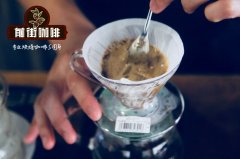What's the difference between iced coffee and cold coffee? how to make iced coffee will take you to know the common iced coffee.

Iced coffee never gets hotter, but crowded markets often lead to product confusion, and someone seems to need a degree in coffee studies from the University of California, Davis (UC Davis) to browse all the iced coffee options in these markets. Although we certainly won't tell anyone how to enjoy coffee here, it's helpful to understand the difference between cold-brewed coffee and frozen coffee before you give an unsolicited speech from an avid barista. More importantly, each method of making iced coffee has its advantages and disadvantages, which can help you know before you use your hard-earned cash on your next brewing machine.
Cold brewing
Technically, all cold coffee is iced coffee, but not all iced coffee is cold coffee. Confusingly, cold brewing refers to the brewing process, which takes a long time to use water cold to room temperature to produce concentrated brewing that is low in acidity but high in caffeine. From the classic Toddy method to the exquisite spiral glass tower, there are many variations in the category of cold-brewed coffee, but they all produce immediately recognizable flavor characteristics (there are some differences in some specialty coffee circles).
Cold cooking is one of the easiest ways to make iced coffee at home, as long as you plan ahead. Our recipe uses a French press, which, when completed, can provide both a container for soaking coffee and a filtering mechanism to remove coffee grounds.
Advantages: easy to make. The shelf life of concentrate is long.
Cons: high levels of caffeine may adversely affect some caffeine.
Japanese iced coffee
One of the classic ways to make iced coffee is usually called Japanese iced coffee. This method is essentially ordinary filtered coffee brewed on an ice bed. Ice quickly cools hot coffee, retaining more volatile acids and creating fresh, refreshing coffee. To avoid excessive dilution of the finished drink, most recipes subtract the mass of ice from brewing water (for example, to make a cup, you may need to use 20 grams of coffee with 200 grams of water and 120 grams of ice). For best results, use cube-shaped thick ice that melts slowly and evenly.
Advantages: crisp, refreshing, fresh. Retain most of the acidity.
Disadvantages: due to the small proportion of brewing, it is difficult to extract completely. Compared with other iced coffee methods, the lightweight body makes it less suitable for adding milk.
Quick-frozen cooling
Quick-frozen cooling may be the least common way to make frozen coffee, but it is a favorite of many coffee professionals for good reason. This method uses a heat exchanger to quickly cool the brewed instant coffee without diluting the coffee. Previously, frozen iced coffee was only made by hardcore family baristas equipped with modified wort coolers, but because of one of our favorite coffee devices since 2017, frozen iced coffee has never been so simple.
Advantages: sweet, delicious, fully extracted iced coffee.
Cons: it takes a long time to re-freeze the heat exchanger on the household flash cooler between brewing.
Iced Americano
As long as you have an industrial espresso machine, it's hard to find an iced coffee method faster than iced American coffee. This classic drink uses only espresso, water and ice. Many baristas pull espresso directly into ice water to reduce dilution. Like cold-brewed coffee, iced American coffee has its disadvantages because some coffee experts believe that emulsified oil tastes unpleasant at lower temperatures.
Advantages: high concentrations of espresso are easy to cool with ice without having to dilute too much.
Cons: not all espresso works as well as chilled Americano.
Conclusion
Which method of iced coffee is the best? Well, it's up to you to decide. However, coffee professionals agree that putting the rest of the coffee in the refrigerator to cool slowly is the worst.
Important Notice :
前街咖啡 FrontStreet Coffee has moved to new addredd:
FrontStreet Coffee Address: 315,Donghua East Road,GuangZhou
Tel:020 38364473
- Prev

What does it mean to be a native species of coffee in Ethiopia's Sidama Guji region?
Forest coffee or wild-grown coffee trees are produced in the Sidamogugi region along the Mora Mora River in southern Ethiopia. The region also hosts many small coffee farms that pool coffee in cooperatives for grinding and export. The typical variety in the Guji region is the heirloom. it is important for us
- Next

Philharmonic pressure usage tutorial | you can taste the fragrant coffee in only 6 steps. How to Aeropress
The barista's biggest worry is that can you grind for the Aeropress? Although you can always rely on espresso for fine grinding and quick brewing, while the French kettle is the opposite, Aeropress's extraction solutions are everywhere, and most of them are very bad. First of all, completely ignore the formula on the box. There is no doubt that Alan, the legendary inventor of Aeropress
Related
- Detailed explanation of Jadeite planting Land in Panamanian Jadeite Manor introduction to the grading system of Jadeite competitive bidding, Red bid, Green bid and Rose Summer
- Story of Coffee planting in Brenka region of Costa Rica Stonehenge Manor anaerobic heavy honey treatment of flavor mouth
- What's on the barrel of Blue Mountain Coffee beans?
- Can American coffee also pull flowers? How to use hot American style to pull out a good-looking pattern?
- Can you make a cold extract with coffee beans? What is the right proportion for cold-extracted coffee formula?
- Indonesian PWN Gold Mandrine Coffee Origin Features Flavor How to Chong? Mandolin coffee is American.
- A brief introduction to the flavor characteristics of Brazilian yellow bourbon coffee beans
- What is the effect of different water quality on the flavor of cold-extracted coffee? What kind of water is best for brewing coffee?
- Why do you think of Rose Summer whenever you mention Panamanian coffee?
- Introduction to the characteristics of authentic blue mountain coffee bean producing areas? What is the CIB Coffee Authority in Jamaica?

